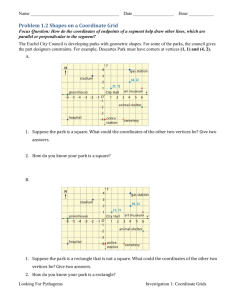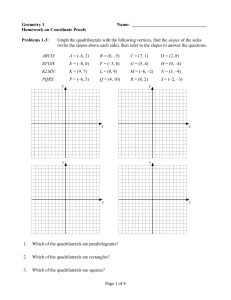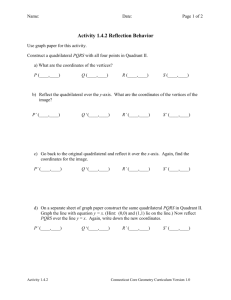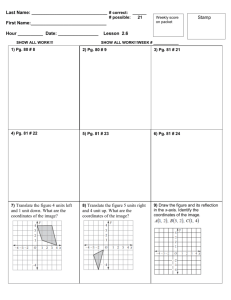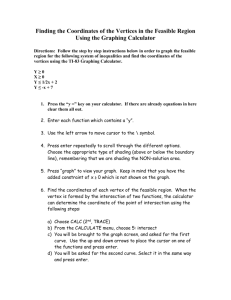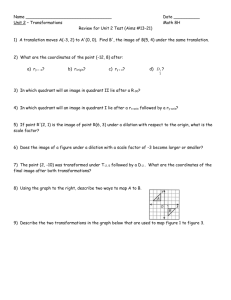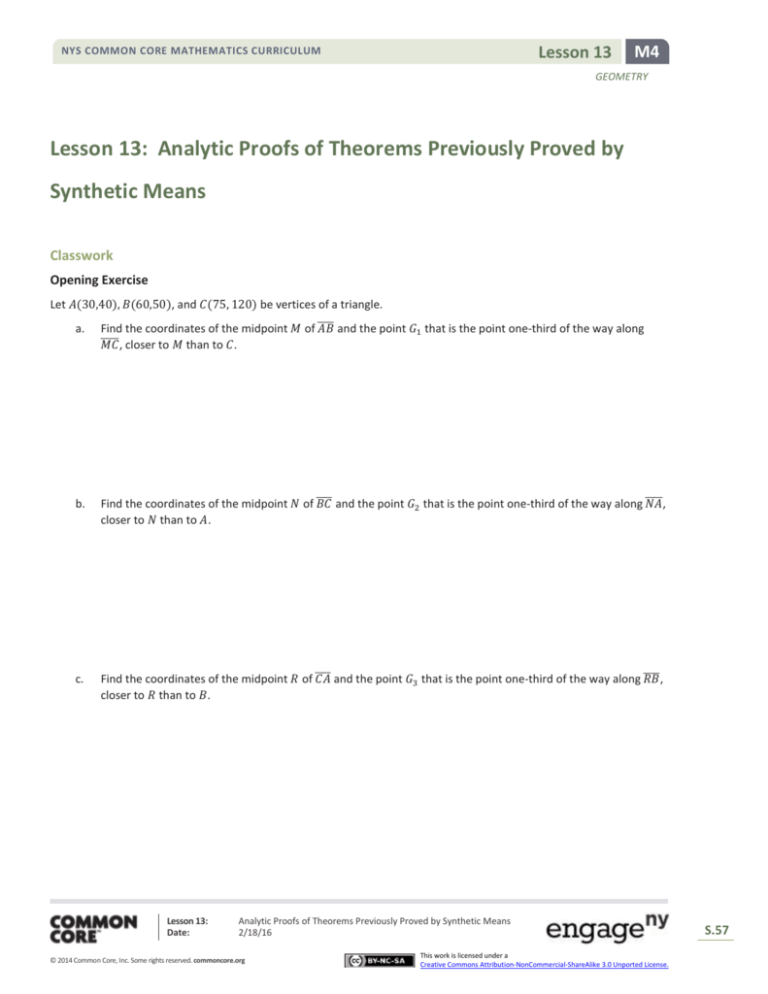
Lesson 13
NYS COMMON CORE MATHEMATICS CURRICULUM
M4
GEOMETRY
Lesson 13: Analytic Proofs of Theorems Previously Proved by
Synthetic Means
Classwork
Opening Exercise
Let 𝐴(30,40), 𝐵(60,50), and 𝐶(75, 120) be vertices of a triangle.
a.
Find the coordinates of the midpoint 𝑀 of ̅̅̅̅
𝐴𝐵 and the point 𝐺1 that is the point one-third of the way along
̅̅̅̅̅ , closer to 𝑀 than to 𝐶.
𝑀𝐶
b.
Find the coordinates of the midpoint 𝑁 of ̅̅̅̅
𝐵𝐶 and the point 𝐺2 that is the point one-third of the way along ̅̅̅̅
𝑁𝐴,
closer to 𝑁 than to 𝐴.
c.
Find the coordinates of the midpoint 𝑅 of ̅̅̅̅
𝐶𝐴 and the point 𝐺3 that is the point one-third of the way along ̅̅̅̅
𝑅𝐵 ,
closer to 𝑅 than to 𝐵.
Lesson 13:
Date:
Analytic Proofs of Theorems Previously Proved by Synthetic Means
2/18/16
© 2014 Common Core, Inc. Some rights reserved. commoncore.org
This work is licensed under a
Creative Commons Attribution-NonCommercial-ShareAlike 3.0 Unported License.
S.57
Lesson 13
NYS COMMON CORE MATHEMATICS CURRICULUM
M4
GEOMETRY
Exercise 1
a.
Given triangle 𝐴𝐵𝐶 with vertices 𝐴(𝑎1 , 𝑎2 ), 𝐵(𝑏1 , 𝑏2 ), and 𝐶(𝑐1 , 𝑐2 ), find the coordinates of the point of
concurrency.
b.
Let 𝐴(−23, 12), 𝐵(13, 36), and 𝐶(23, −1) be vertices of a triangle. Where will the medians of this triangle
intersect?
Lesson 13:
Date:
Analytic Proofs of Theorems Previously Proved by Synthetic Means
2/18/16
© 2014 Common Core, Inc. Some rights reserved. commoncore.org
This work is licensed under a
Creative Commons Attribution-NonCommercial-ShareAlike 3.0 Unported License.
S.58
Lesson 13
NYS COMMON CORE MATHEMATICS CURRICULUM
M4
GEOMETRY
Exercise 2
Prove that the diagonal of a parallelogram bisect each other.
Lesson 13:
Date:
Analytic Proofs of Theorems Previously Proved by Synthetic Means
2/18/16
© 2014 Common Core, Inc. Some rights reserved. commoncore.org
This work is licensed under a
Creative Commons Attribution-NonCommercial-ShareAlike 3.0 Unported License.
S.59
Lesson 13
NYS COMMON CORE MATHEMATICS CURRICULUM
M4
GEOMETRY
Problem Set
1.
Point 𝑀 is the midpoint of segment ̅̅̅̅
𝐴𝐶 . Find the coordinates of 𝑀:
a.
𝐴(2, 3), 𝐶(6, 10)
b.
𝐴(−7, 5), 𝐶(4, −9)
2.
𝑀(−2, 10) is the midpoint of segment ̅̅̅̅
𝐴𝐵 . If A has coordinates (4, −5), what are the coordinates of 𝐵?
3.
̅̅̅̅ with 𝐵(−2, −1) and 𝐶(4, 1).
Line 𝐴 is the perpendicular bisector of segment 𝐵𝐶
a.
b.
c.
d.
What is the midpoint of ̅̅̅̅
𝐵𝐶 ?
̅̅̅̅
What is the slope of 𝐵𝐶 ?
What is the slope of line 𝐴? (Remember, it is perpendicular to ̅̅̅̅
𝐵𝐶 .)
̅̅̅̅
Write the equation of line 𝐴, the perpendicular bisector of 𝐵𝐶 .
4.
Find the coordinates of the intersection of the medians of △ 𝐴𝐵𝐶 given 𝐴(−5,3), 𝐵(6, −4), and 𝐶(10, 10).
5.
Use coordinates to prove that the diagonals of a parallelogram meet at the intersection of the segments that
connect the midpoints of its opposite sides.
6.
Given a quadrilateral with vertices 𝐸(0, 5), 𝐹(6, 5), 𝐺(4, 0), and 𝐻(−2, 0):
a.
Prove quadrilateral 𝐸𝐹𝐺𝐻 is a parallelogram.
b.
Prove (2, 2.5) is a point on both diagonals of the quadrilateral.
7.
Prove quadrilateral 𝑊𝑋𝑌𝑍 with vertices 𝑊(1, 3), 𝑋(4, 8), 𝑌(10, 11), and 𝑍(4, 1) is a trapezoid.
8.
Given quadrilateral 𝐽𝐾𝐿𝑀 with vertices 𝐽(−4, 2), 𝐾(1, 5), 𝐿(4, 0), and 𝑀(−1, −3):
a.
Is it a trapezoid? Explain.
b.
Is it a parallelogram? Explain.
c.
Is it a rectangle? Explain.
d.
Is it a rhombus? Explain.
e.
Is it a square? Explain.
f.
Name a point on the diagonal of 𝐽𝐾𝐿𝑀. Explain how you know.
Lesson 13:
Date:
Analytic Proofs of Theorems Previously Proved by Synthetic Means
2/18/16
© 2014 Common Core, Inc. Some rights reserved. commoncore.org
This work is licensed under a
Creative Commons Attribution-NonCommercial-ShareAlike 3.0 Unported License.
S.60

